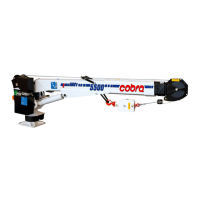7
5.3 RULES FOR THE CORRECT POSITIONING OF THE CRANE
5.3.1Choice of crane operating place pressure on the ground
• Carefully choose the place where lowering and put into action the stabilizers of the crane outriggers.
The most important thing is the capacity of the ground to bear the pressure produced by the outriggers.
• Make sure that the outriggers working area is free from underground piping, tunnels, holes.
• The positioning must be carried out so as to operate the crane with the shortest outreach possible and
without any obstacle in the working area.
• Never move the crane from its rest position without stabilizing the truck.
• The outriggers reaction is transmitted to the ground by steel pads. When this pressure exceed the
maximum admittable pressure value of the ground, the surface of their bearing area must be increased
by means of additional plates of firm material (i.e. wooden plates). The outriggers pads must work in the
middle of the additional plates. The required bearing surface can be easily calculated as follows
when the outrigger’s reaction and the admittable pressure on the ground are known. Outrigger’s
reaction: look at the plate applied on the outrigger jack. Admittable pressure on various types of soils:
look at the following table for indicative values.
Bearing pressure calculation
When: Then:
t = outrigger’s reaction (tons) (US ton) p = bearing pressure on ground (daN/cm
2
) (lbs./Sq.in.)
A = bearing plate surface (cm
2
) (sq. in.)
p = (1000 • t) : A (metric)
p = (2000 • t) : A (U.S.A.)
ATTENTION
In case of doubts on the ground carrying capacity, make a hardness test of the ground.
Always level the crane acting on outriggers with reference to the level indicator fitted on the truck. Maximum
admittable angle is 3°.
5.3.2Safety distance from trencher and slopes
The crane must be positioned sufficiently far away from trenches or slopes. The safety distance depends
also on the soil, if the slopes or trenches are not sustained. Rule of the thumb: (look at the following picture)
SOIL ADMITTABLE PRESSURE
(daN/cm
2
) (lbs./sq.in.)
Dumped, non compacted soi 0.0/1.0 0,0/14
natural, virgin soil:
-mud, marshland, peat 0.0 0,0
incoherent artificially compacted soils:
-fine and medium size sand 1.5 21
-large size sand, gravel 2.0 28
natural coherent terrain:
-doughy 0.0 0,0
-soft. 0.4 6
-stiff 1.0 14
-demi-solid 2.0 28
-solid 4.0 56
rock, not altered by athmospheric agents, well stratified and slightly cracked:
-closed stratified 15.0 213
-solid stratified, pillar-like 30.0 426

